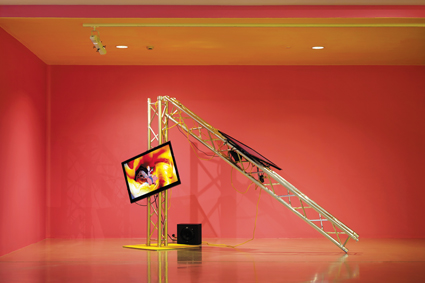Intoxicating media anxieties
Ella Mudie: TV Moore’s Rum Jungle

TV Moore, Pig GIF, 2014
photo Zan Wimberley
TV Moore, Pig GIF, 2014
Typically the task of a survey is to historicise and contextualise an artist’s practice with the aim of revealing how it has unfolded over time and where it is headed. There was a certain novelty then in the idea of one of the boundary riders of Australian media art, TV Moore, self-curating his recent mid-career survey, Rum Jungle, at Campbelltown Arts Centre. While expecting an exhibition that was a bit out of the ordinary, it was a surprise to discover to what extent Moore had engineered what was essentially an anti-survey, a kaleidoscopic romp designed to pervert the conventions of the survey in the most delirious and disorienting fashion possible.
Having transformed the gallery’s white walls into a lurid candy-coloured space, Rum Jungle was worlds apart from the pared back gothic spectrality of the video works for which Moore became renowned during the 2000s. With no catalogue or wall plaques the viewer was encouraged to explore the galleries intuitively rather than programmatically. Predominantly comprising Moore’s recent hyperactive cartoon animations, colour-saturated psychedelic painting-photographs and light box imagery, Rum Jungle’s presentation of mainly new work was lightly contextualised by a condensed presentation of Moore’s earlier body of work.
For all its claims to happy anarchy then, Rum Jungle actually appeared a brave refusal on the artist’s part to reify his own practice. The works were not chronologically arranged, however the inclusion of a handful of earlier pieces provided clues as to how to decode the exhibition’s logic. A key work in this respect was Moore’s 2009 video installation, What Say U Wii?, a single projection portrait of an adult video gamer in a blond wig and oversized nerd glasses who riffs into the camera on the merits of Wii vs Nintendo DS. Filmed against the distinctive green of the chroma key screen, a trigger for the gallery’s brightly-hued walls, the juxtaposition of an adult slacker persona with the soundtrack of a young boy’s voice projected a sense of dislocated identity that anchored Moore’s concern in Rum Jungle to explore the psychological implications of virtual immersion.
TV Moore has long exhibited a preoccupation with the subliminal elements of screen culture. His recent transition to animated video extends these concerns albeit in the more spatial medium of cartoons, in which moving figures exist in a state of a-temporal flux, rather than in the more temporally complex and richly allusive medium of film. For the presentation of two animated GIF works, Pig GIF (2014) and Bike GIF (2014), Moore installed the pair of animations on flat-screen monitors placed at crooked angles on a partially collapsed piece of metal scaffolding. In Pig GIF a man clutches a beer in one hand and rides cavalierly upon the back of a pig cantering horizontally across the screen while a visual collage of sexy consumer imagery pulsates in the background. Banal yet seductively hypnotic, the sped-up time of the GIF amplifies the alienation of the surface and signals the dystopia of psychological space constituted by repetition and depthlessness.
The trope of the outsider figure has underpinned some of Moore’s most memorable works such as his acclaimed video cycle The Neddy Project (2001-04). While not an explicit feature of Rum Jungle, the outsider was present in a few guises including in a pair of future primitive light box images featuring the artist inhabiting the identity of hermitic painter Ian Fairweather. One of the Fairweather images was sited near Moore’s suite of nine cibachrome print paintings, Rum Jungle Series (2014), deepening the allusions to outsider art in the works. In this suite of abstracted art brut-style portraiture, Moore melds recurring motifs like the free-floating eye with broad gestural brush strokes and thick drips and smears of paint. Yet in presenting the paintings in the smooth high-gloss finish of the cibachrome print the sensuality of the painted surface is negated and transformed into a more standardised photographic serialisation.
While Rum Jungle allocated generous space to the new works, the history of Moore’s video practice was largely confined to the darkened interior of a single room with the atmosphere of a time capsule. The effect of pulling together several multi-channel installations into an assemblage of videos screened on old analogue television sets was of a polyphonous quoting and sampling of past projects. The aural assault of the sound bleed between videos was not conducive to focused viewing, although one work presented fairly discretely was The Dead Zone (2003). More than a decade after its initial presentation the portrait of a possibly hunted man stumbling and tripping backwards through a deserted cityscape still conveys a palpable sense of post-millennial unease.
Rum Jungle presented itself as an intoxicated and chaotic ramble through a psychedelic fun parlour but ultimately its seductive surfaces were a ruse. Across a decade of video practice, TV Moore peered into the dark recesses of screen culture as a void into which we project our desires only to have their fulfilment endlessly deferred. Rum Jungle did not suggest an abandonment of these concerns but continuation in a new guise—the manic intensity of its trippy animated world was far from innocent whimsy but confronted the viewer, rather, with a discomforting harbinger of the inevitable alienations of a depthless future.
TV Moore’s Rum Jungle, Campbelltown Arts Centre Sydney, 22 March–25 May
RealTime issue #121 June-July 2014 pg. 53






